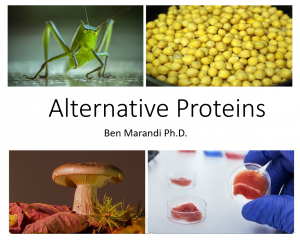The future of alternative proteins and in its impact on food industry

By 2050, world will require to meet the nutritional demands of more than 10 billion people. While protein is an essential part of our nutrition, it would be almost impossible to feed 10 billion people with the amount and type of general protein, which is a typical of current diets of North America and Europe with current food production system. In addition, this substantial increase in meat production would be in total discord with the 2015 Paris Climate Agreement. The negative impact on environment and climate change with conventional production of protein is far more challenging than ever. Moreover, the controversial direct relationship of meat consumption to adverse human health is almost on daily discussion among health practitioners and nutrition professionals.
Alternative proteins that can be valuable substitutes for traditional animal‑based food. They signify a major change and shift in dietary demands. The most known and successful alternative proteins are based on plant material (soy, peas, lupine, rice, etc.), insects such as crickets , lab-grown or cultured meat and mycoproteins.
The immediate reasons for this shift comes from three obvious facts. First, healthy ingredients in some alternative proteins in particular in plant-based proteins such as high amount of fibre and lack of high content of saturated fatty acids which can be found in most of animal sourced-protein. It is stated by World Health Organization that around 30% of the world’s population is overweight/obese. While animal sourced meat is both energy-dense and protein-rich, overconsumption of meat contributes to growing rates of obesity and higher risk for non-communicable diseases. It should be noted that there is divided consensus among health practitioners and epidemiological scientists of the consumption of animal sourced protein results to adverse health impact. Second, alternative protein is usually free of hormones and antibiotics and veterinary medicines found in protein originated from livestock. Third, the alternative proteins are obvious alternative for climate change mitigation. It is fact that livestock animals are major source of greenhouse emission. FAO stated that the total emissions from global livestock represent 14.5% of all anthropogenic GHG emissions. Meat production is the most impacting activity in food production.
While the pathway to meet the demand of growing population for protein from conventional animal sourced-protein seems very challenging. In fact is highly unlikely for alternative proteins to reach the scale that meet the demand of 10 billion people. There are several criteria that have to be met. First, products based on alternative protein should at minimum taste as good as the taste of animal sourced protein. This is one key elements among meat eaters. At current, the lack of familiarity and negative perception of alternative protein sensory properties is one of the key barriers to entry of these products to the table of meat lovers. The emergent of Beyond Meat burger, which looks and tastes with almost same nutritional values of meat burger proves that industry is keeping up with demand of plant-based proteins consumers. Second, regulatory processes to cover the use of novel ingredients and cell-cultured products need to be established and harmonized not only in US and EU but at global stage. Third, the current production methods of alternative proteins are barely enough to meet the demands of next generation; therefore the productions processes and technologies have to be revolutionized, especially for cell cultured meat and insect proteins.
Nevertheless, the world has a long way with lots of obstacles to provide the human growing population with the quantity and quality of protein required, at reasonable prices and in a manner that is both sustainable and ideal for human health. One of the most obvious element for consumer selection is cost. Indeed cost is a crucial factor in the consumer value perception. However, there is no single winner for this key parameter for customer selection between these two contestants. Some of alternative proteins can barely compete in a more sustainable manner with currently priced beef or pork. This demonstrates at current, consumers are not inevitably persuaded to diversify their diets with these choices.
It is not difficult to predict that both meat and alternative protein industries will stay in the market for indefinite time; however, with a major shift to increase demand for alternative proteins. This shift has already been started with technological advancement is taste and texture, the inarguably benefits for environment and health benefits for consumers, the facilitation of some governments in establishing more relaxing regulations, and the increasing number of major investment by major food companies in alternative protein start-ups.
1. Meat: the Future series Alternative Proteins-World Economic Forum-H Charles J Godfray, Oxford Martin School, Oxford University
2. Livestock’s Long Shadow: Environmental Issues and Options- Steinfeld et al. 2006
3. Godfray, H. C. J. et al. “Food security: The challenge of feeding 9 billion people”. Science vol. 327, 2010,
4. Tilman, D., Balzer, C., Hill, J. and Befort, B. L. “Global food demand and the sustainable intensification of agriculture”.
5. World Business Council for Sustainable Development. Food and Land Use, 2018
6. http://www.fao.org/news/story/en/item/197623/icode/
7. https://www.weforum.org/agenda/2019/01/how-can-we-produce-enough-protein-to-feed-10-billion- people/

